
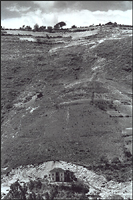
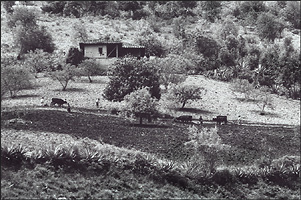
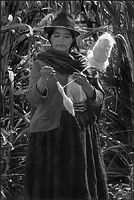
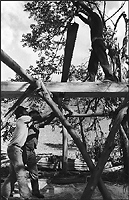
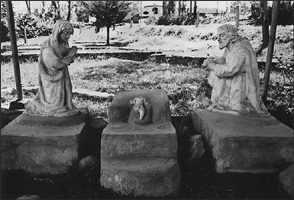
Home Ecuador
Although the area was not heavily populated, there was nearly always a house or field nearby. At most houses along the path, one or several dogs would come out to bark, and this comprised one of the commonest sounds to be heard while walking in the mountains. Some others were those made by the sheep, roosters, chickens, turkeys, or the music from radios and record players. Occasionally some grunting from family pigs would emanate from the thatched shelter in the fields where they lay snorting peacefully in the dusty shade. Wild birds, frogs, and crickets added their melodies, along with the wind rustling the branches of the eucalyptus, or cherry and peach trees. From the fields would come the distinctive “whisht”, the sound that the men made with their lips as they prodded their oxen with cane poles into pulling the heavy wooden plow. Sometimes this was accompanied by the thudding of a pick-axe as the women followed behind, shattering the hard clods of dirt.
The Incan tradition of working and carving stones was sometimes brought to mind when I happened upon a system of irrigation ditches that appeared to have been dug into solid rock. In another area, where there was much evidence of rampaging waters from recent rains, there was more of this irrigation work, including some done in concrete. I continued on past this area and followed the path over the stone and up a hill. The terrain was unusually rocky and the fields were full of loose pieces of conglomerate, light in weight, and shelves of sandstone lay bared to the sun. This abundance was put to use in building walls of all sorts and, especially along the ridgetop, the houses were partly walled with the stone with a mud mortar. The remaining walls were the usual mud bricks. The fields along this ridgetop were characterized by the ruins of several houses, overgrown with trees and cactus. These all consisted of assorted stone-work walls, the insides of which had numerous niches formed into them, an Incan building tradition. Near each of these sites, where rock had been exposed by the elements, holes had been carved in circles or rectangles, sometimes several feet deep. These might have originally been used for food storage, or water reservoirs. They were now filled with brownish water populated by algae and tadpoles which cruised like jerky submarines while nourishing fantastic dreams of leap-frogging.
The Indians who inhabited the mountains were somewhat shy. Those who identified more with the dominant Spanish culture were more outgoing, but all were friendly, particularly if they had been drinking. In town or country, if was difficult to refuse an offer of a drink without feeling as if it were an insult. At least it wasn’t necessary to go out and get in the car and possibly kill yourself or your neighbors. An accident on foot was usually less life-threatening.
One day while walking through Bulcáy, I passed a house where a small party was in progress. Five or six men were sitting about on the porch, and they practically dragged me over to join them. They were all thoroughly drunk from Zhumir, and my arrival signaled several more rounds. I asked the occasion of the merry-making, and was told “friendship, no mas”. It’s the tradition to shake hands all around when arriving or departing, and when one of the gathering wishes you to remain, holding on to the proffered hand is a sure means of accomplishing that task. On another day I was climbing in the hills east of town. The trail took me by a house where there were a number of people standing about. At the next house I was met by an inebriated fellow with a bottle in hand. He was also carrying a shot glass, and wouldn’t let me continue until I’d taken a hit of the colorless trago. Further on I met some people from Gualaceo whose family, typically, owned some land in “el campo”. They were going there to pick some peaches and invited me along. Besides the peaches, there were figs, nogales (a round, brownish-green fruit), and a guayaba tree that yielded a small version of this fruit. Between the trees were planted rows of corn and beans. They gave me some peaches, and I continued on my walk. On the way back down the mountain, I encountered the same man with the bottle, but in the interval he had traveled a good deal further down the road to oblivion. He offered me another drink, and the people at the house invited me over. They wanted to treat me to special brew, and a man emerged from the house carrying a bottle which contained a bright orange fluid. It tasted sweet and fruity, and not strongly alcoholic. They gave me a second cup, and then insisted I step inside one of the buildings. A group of women were sitting around inside, while the men and I passed by on our way inside. The room was empty but for some benches placed along the walls. It was arranged for dancing, and a small phonograph had been placed on a windowsill. I discovered that a marriage was the occasion for the celebration. We toasted the husband, the wife, the United States, Ecuador, and several other things, and I attempted to leave, but found myself back on the bench with all the men crowded around. Soon I had to refuse any more drinks if I were to leave at all, and I made good my exit before the dancing had even started. However, a man chased me down the path with bottle and glass in hand saying “just one more”. For friendship.
Some other mountain acquaintances just enjoyed conversing with a stranger, particularly one from the United States, where everyone was rich. So believed Rosendo, among other things. One day I passed his house where the front yard was adorned with straw hanging on lines and railings, drying in the warm morning air. It was being given treatments to make it suitable for weaving hats. Rosendo appeared and invited me into a room to rest. It was dark and bare but for some burlap sacks on the floor, which he kicked aside, one chair, and the cabinet of a sewing machine. The odor of a decaying rat was a prominent element of the atmosphere, and rosendo pointed this out, postulating that it was somewhere beneath the floor. We talked about the straw, and he took me outside to a large wooden box. It was used for smoking the straw which was hung on racks inside. The burning sulphur powder was placed in an opening at the bottom of the box, and this smoke had a bleaching effect on the straw.
Rosendo had more on his mind than the straw. He claimed that he owned more land in the Oriente, and he wondered if I’d be interested in buying the parcel here in Gualaceo. I told him that I wasn’t, but he was proud to show me around the property anyway. We walked down a hill between rows of corn and beans. The sun was hot, and we sat down in the shade of a chiramoya tree. Across a patch of open ground was a grove of pear trees. We talked for a while as we relaxed, but the topic of conversation kept coming around to the same topic. I had told him that I’d been married for over a year, and he was very interested in knowing why I hadn’t had any children. I told him that Peggy and I just weren’t ready for any yet, but we’d probably have some later. He apparently found this explanation peculiar. He stared at me a little incredulously, kept chuckling, patting me on the shoulder, and saying “Que gringo! Que gringo!"